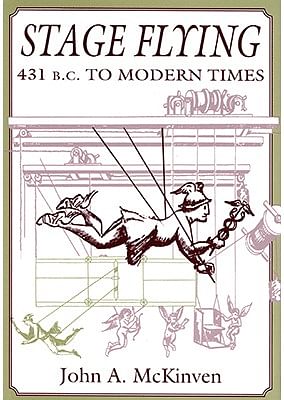Stage Flying: 431 B.C. To Modern Times by John A. MicKinven
Reviewed by Jamy Ian Swiss (originally published in Genii August, 2005)

David Meyer continues to add to his unique and wonderful catalog of conjuring and
theatrical literature with this fascinating new title. This volume is beautifully produced—
as I find increasingly typical of Myerbooks—and is a satisfying and delightful product in
every possible way. The author has expended yeoman effort in producing, the result of
two decades of research, a remarkably readable and erudite work. Beginning with the production of Euripides' "Medea" in 431 BCE in Greece—when Medea appeared to take
flight in a dragon-drawn chariot at the conclusion of the production—and through the
recent productions of Angels in America and Millennium Approaches, wherein the
legendary technology of "Flying by Foy" enables an angel to crash through the ceiling
and turn somersaults in the air—this book traces the history of theatrical flying from
past to present. There is an important distinction to which the reader's attention must
be drawn: this is a book about the specific feat of flying, by means sometimes partially
but never entirely concealed, in theatrical productions; it is not a book about the
levitation illusions of magicians. Although there is certainly a relationship between these
two subjects—parallels in effect and methodology that ebb and flow throughout their
respective histories—the author, in a carefully worded epilogue, is at pains to explain
that the conjuror's illusions, with specific references to David Copperfield and Siegfried
and Roy, are "...outside the scope of this book..."
Nevertheless, the informed illusionist and illusion designer will find a great deal of
interest in the detailed mechanical descriptions and diagrams that are provided
throughout this text, hand-in-hand with an engrossing narrative of theatrical history
and evolution. Flying has been a live special effect from biblical recreations in the 14th
and 15th centuries, to medieval passion plays, through Medici-sponsored Renaissance
productions and Baroque theater, into 19th century variety entertainment and on to
Peter Foy's 20th century Peter Pan breakthroughs—and even Shakespeare couldn't
resist. A stage direction included in the bard's own Cymbeline reads, "Jupiter descends
in thunder and lightning, sitting upon an angel. He throws a thunderbolt. The Ghosts
fall on their knees." Hey, who wouldn't?

